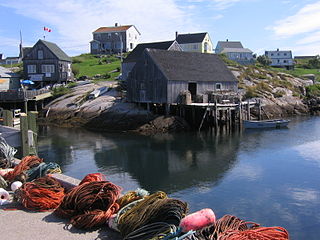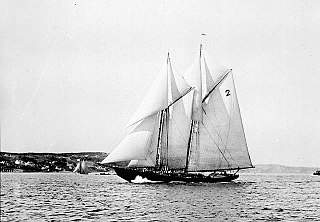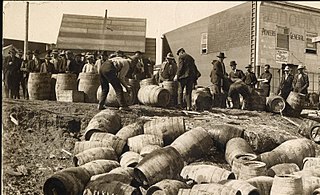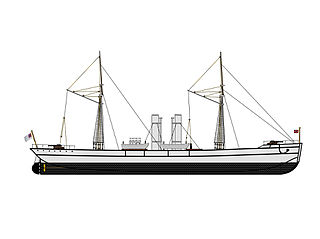
The Maritimes, also called the Maritime provinces, is a region of Eastern Canada consisting of three provinces: New Brunswick, Nova Scotia, and Prince Edward Island. The Maritimes had a population of 1,813,606 in 2016, which makes up 5.6% of Canada's population. Together with Canada's easternmost province, Newfoundland and Labrador, the Maritime provinces make up the region of Atlantic Canada.

Bluenose was a fishing and racing gaff rig schooner built in 1921 in Lunenburg, Nova Scotia, Canada. A celebrated racing ship and fishing vessel, Bluenose under the command of Angus Walters, became a provincial icon for Nova Scotia and an important Canadian symbol in the 1930s, serving as a working vessel until she was wrecked in 1946. Nicknamed the "Queen of the North Atlantic", she was later commemorated by a replica, Bluenose II, built in 1963. The name Bluenose originated as a nickname for Nova Scotians from as early as the late 18th century.

USS Irene Forsyte (IX-93) was a three masted schooner originally built as MacLean Clan which was briefly converted to a Q-ship, of the United States Navy.

The Northumberland Strait is a strait in the southern part of the Gulf of Saint Lawrence in eastern Canada. The strait is formed by Prince Edward Island and the gulf's eastern, southern, and western shores.

Pictou Town is a town in Pictou County, in the Canadian province of Nova Scotia. Located on the north shore of Pictou Harbour, the town is approximately 10 km north of the larger town of New Glasgow.

Canso is a community in Guysborough County, on the north-eastern tip of mainland Nova Scotia, Canada, next to Chedabucto Bay. In January 2012, it ceased to be a separate town and as of July 2012 was amalgamated into the Municipality of the District of Guysborough.

Rum-running or bootlegging is the illegal business of smuggling alcoholic beverages where such transportation is forbidden by law. Smuggling usually takes place to circumvent taxation or prohibition laws within a particular jurisdiction. The term rum-running is more commonly applied to smuggling over water; bootlegging is applied to smuggling over land.

The Diocese of Nova Scotia and Prince Edward Island is a diocese of the Ecclesiastical Province of Canada of the Anglican Church of Canada. It encompasses the provinces of Nova Scotia and Prince Edward Island and has two cathedrals: All Saints' in Halifax and St. Peter's in Charlottetown. It is the oldest Anglican diocese outside the British Islands. Its de facto see city is Halifax, and its roughly 24 400 Anglicans distributed in 239 congregations are served by approximately 153 clergy and 330 lay readers according to the last available data. According to the 2001 census, 120,315 Nova Scotians identified themselves as Anglicans, while 6525 Prince Edward Islanders did the same.

The CSS Tallahassee was a twin-screw steamer and cruiser in the Confederate States Navy, purchased in 1864, and used for commerce raiding off the Atlantic coast. She later operated under the names CSS Olustee and CSS Chameleon.

Wood Islands is a rural farming and fishing community located in southeastern Queens County, Prince Edward Island on the Northumberland Strait. It takes its name from several small forested islands, then located several hundred metres offshore in the Northumberland Strait. The community of Wood Islands falls within the larger PEI Township of Lot 62, which had a population in 2011 of 470 residents, a 13% decrease from the 2006 census count of 540. While the named islands are located on maps by Jacques-Nicolas Bellin: Karte Bellin, 1744: 'I a Bova' and Louis Franquet: Cartes Franquet, 1751: 'Isle a Bois', it was Samuel Johannes Holland who correctly surveyed and depicted the islands, about their basin. The 'European' settlement of Wood Islands began in 1803, but saw its most noted arrivals in 1807 with the arrival, after wintering in Pinette, of a large party of Scottish settlers from the Spencer.

Sailing in Anguilla has a long and deep history, and is one of the defining characteristics of the island. The history of Anguillian sailing is often indistinguishable from the history of the island itself. Sailing craft date back to the Taino and Arawak peoples who inhabited Anguilla before the British Colonisation. However these craft have had little influence on the unique sailing practiced in Anguilla. Instead, it originated from the fishing vessels constructed and built locally after colonization and the subsequent collapse of the local plantation system to provide food and modest income to the inhabitants.

Edward Jordan (1771–1809) was an Irish rebel, fisherman and pirate in Nova Scotia. He was typical of the violent but short-lived pirates in the 19th century following the end of "Golden Age of Piracy" in the 18th century. Born in County Carlow, Ireland, he took part in the Irish rebellions of 1797–1798 but was pardoned and attempted to start a new life as a fisherman in Nova Scotia. However his seasonal fishing operation based at Gaspe Bay was unsuccessful and he racked up large debts. Halifax merchants seized his fishing schooner, The Three Sisters. On 13 September 1809, desperate to avoid losing the schooner, he tried to murder all of the crew sent to seize his schooner. He killed two sailors but the captain, John Stairs, was only wounded and managed to escape overboard. Stairs was rescued by a passing fishing schooner and survived to spread the alarm. A few weeks later the Royal Navy schooner HMS Cuttle captured Jordan.
Halifax commonly refers to:

HMS Mosquidobit was the Chesapeake-built six-gun schooner Lynx that the British Royal Navy captured and took into service in 1813. She was sold into commercial service in 1820 and nothing is known of her subsequent fate.

In Canadian ghostlore, the Ghost Ship of Northumberland Strait is a ghost ship said to sail ablaze within the Northumberland Strait, the body of water that separates Prince Edward Island from Nova Scotia and New Brunswick in eastern Canada.

Richard Moses Murphy (1838–1916) was a well-known schooner captain who sailed out of Gloucester, Massachusetts during the late 1800s. Some of his experiences as a mariner are detailed in a chapter titled "The Adventures of Captain Richard Murphy" in The Fisherman’s Own Book, published by Proctor Brothers in 1882.
Henry W. Embree and Sons, Boatbuilders, was a boat yard in Port Hawkesbury, Nova Scotia, that operated from 1859 to 1948. The youngest son of a boatbuilding family, Henry Embree established his own boat yard between Brown and Pitt Streets, on the Port Hawkesbury waterfront, next to the P. Paint and Sons warehouse.

I'm Alone was a Canadian ship used as a rum runner during Prohibition in the United States. The auxiliary schooner was built in Lunenburg Nova Scotia in 1923, and for six years, she transported contraband alcohol. Another source says the ship was built in the United Kingdom. Her registry was in Lunenburg, Nova Scotia. I'm Alone was intercepted in the Gulf of Mexico off the coast of Louisiana by USCGC Wolcott on 22 March 1929, as the schooner was returning from Belize with liquor. The crew of I'm Alone disobeyed orders to stop and was shelled and sunk by USCGC Dexter. Seven of the ship's eight crew members were rescued. The eighth, a French Canadian boatswain, Leon Mainguy, died. The surviving crew members, including captain John "Jack" Randell, were arrested and jailed in New Orleans.
SS Ossifrage was a Canadian barge that hit a shoal in the Northumberland Strait in 1919, while she was being towed from Wallace, Nova Scotia, Canada to Souris, Prince Edward Island, Canada.
The FV Flora Alberta was a Canadian auxiliary fishing schooner based out of Lunenburg, Nova Scotia. She was launched in 1941 by Smith and Rhuland, the company's 187th vessel. The managing owner of the vessel was fishing company Adams & Knickle.














